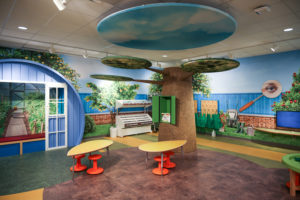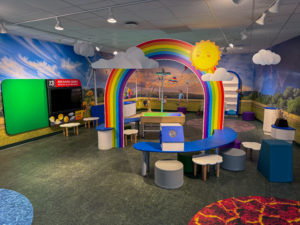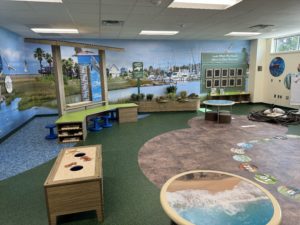Imagine being five years old and this is what going to school looks like: you get to climb aboard a simulated rocket ship and feel the rumble of takeoff. You not only learn about dinosaurs but also dig for fossils in a mock archaeological site. Before you go to lunch, you get to check on the vegetables you planted in Farm to Table. After you eat, you’re experiencing the joy of festive street dancing in Mexico and braving the chill of the Arctic with your best penguin friends.
At Exploration Zones by Exhibit Concepts, Inc., we make these scenarios a reality by bringing hands-on experiences of children’s museums into classrooms. With over 45 years of experience designing, fabricating, and installing award-winning museums such as the Computer History Museum, the Mississippi Civil Rights Museum, Leonardo’s Children’s Museum, the American Museum of Science and Energy, and more, we understand how to create environments that captivate and educate young minds. Even more specifically, our experience extends to designing educational field trip destinations that blend museum-quality exhibits with experiential education, making us uniquely equipped to transform traditional classrooms into interactive learning environments; see John L. Santikos Micronaut Center, Intellizeum and Naturezeum, and Edwards Aquifer Authority.
The Magic of Children’s Museums:
Children’s museums play a crucial role in early childhood education by providing interactive, sensory-rich experiences that fosters curiosity and exploration. These environments engage multiple senses, provide hands-on learning, create lasting impressions, and the ultimate goal; encourages a life-long love of learning. Children’s museums are clearly valued, as they attract 31 million children annually in the US (Association of Children’s Museums, 2021).
Think about your childhood field trip experiences. What stands out the most?
Could similar experiences and memories have been created within a standard classroom?
Key Elements of Children’s Museums Beneficial for Early Learners:
Interactive Learning Stations: Interactive learning stations in museums allow children to explore concepts through touch, sound, and sight. For example, a science station might let them conduct simple experiments, while an art station could offer materials for creative activities.
Themed Immersive Spaces: Themed spaces provide context and make learning more relatable. Themes such as digging for dinosaur fossils, exploring outer space, sifting for gold, or understanding farm-to-table processes offer immersive experiences that traditional classrooms often lack. Research indicates that themed environments enhance imagination and contextual learning, crucial for cognitive development.
Hands-On Learning Materials: Incorporating tactile materials helps make abstract concepts concrete. Real-world objects like fossils, plants, furs, or cultural artifacts can turn lessons into hands-on experiences. Sensory learning materials have been proven to improve understanding and retention, making abstract ideas tangible for young learners.
Bringing Those Key Elements of a Museum into the Classroom:
Interactive Learning Stations: Setting up stations that mimic museum exhibits can transform a classroom into a dynamic learning environment. These stations can cater to different learning styles, ensuring every child remains engaged and motivated. Every room we create has specific sensory-rich, interactive learning stations; examples are our weatherman TV studio in Hidden Forces, the microscope interactive in Greenhouse, or the yoga studio in Healthy Me.
Themed Immersive Spaces: Designing classrooms with themes similar to those in museums can make learning more engaging. Immersive environments encourage students to explore and discover, fostering a love for learning. Every room that we create is an immersive space, but this is especially shown in the environments that children are unlikely to visit, such as underwater in the Ocean, deep into the jungle in the Rainforest, or all the way North to the Arctic.
Hands-On Learning Materials: Using real-world objects and tactile materials in everyday lessons can bring subjects to life. For instance, incorporating artifacts, specimens, and interactive displays can enhance sensory learning and make abstract concepts more accessible. Each room that we create has an option for corresponding thematic learning materials. In Pet-Vet, students can view x-rays and provide check-ups to animals, in International District students will experiment with worldly foods, and dig for bones in Journey Through Time.
Benefits of Bringing Museum Elements into the Classroom:
If you’re five years old and your school day involves going to class in Outer Space, on a Farm, under the Ocean, or across different countries, it’s guaranteed to be more fun than worksheets at their desk. This immersive approach makes learning enjoyable and engaging, which is crucial for young children. When students are excited and motivated, they are more likely to absorb and retain information.
If museums can provide this experience, so can your classrooms. These experiences do not have to be a once-a-year field trip; they can be your student’s daily environment. Engaging students through these vivid, hands-on experiences leads to improved academic outcomes, critical thinking, and problem-solving skills. Additionally, these settings cater to diverse learning styles—visual, auditory, and kinesthetic—ensuring that every child can connect with the material in a meaningful way.
At Exploration Zones, we are committed to creating immersive learning environments that inspire curiosity, foster critical thinking, and support diverse learning styles. By bringing the magic of museums into the classroom, we provide students with the tools and experiences they need.
To learn more about how Exploration Zones can transform your classrooms into experiential learning environments, contact us to learn more about our educational offerings and see how we can make a difference in your school district, from Pre-K to CTE. Learn more about our work here.



